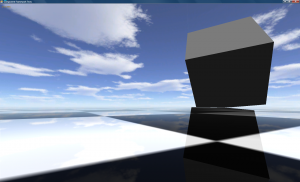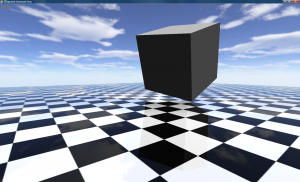Nov. 13th Update : Added fresnel term, min/max reflection factors, pixel-perfect sampling.
Back in TV3D land for a minute!
(the reflection looks offset in these pics but it’s fine in realtime… not sure why it messed up here.)
Description
It might sound like an easy thing to do, but planar reflections are pretty challenging to do per-pixel. It involves a texture projection shader, some pretty scary matrix play, and so on and so forth. So I decided to make a proper sample that shows how I did it in my reflective water sample, but in its simplest expression.
The floor uses two mesh groups, one for the reflection and one for the actual floor with texture. This makes it possible to only use a shader on the reflection group, and then the other one uses standard TV3D rendering.
Sadly, it’s impossible to do per-pixel reflections without a shader. Thinking about it, an even simpler way would be to use the stencil buffer, but then if you’re working with pixels you can apply fun effects like bump-mapping and fresnel attenuation.
Update Notes
The updated version has fresnel per-pixel attenuation, which means that grazing angles will get full reflection and looking down on the floor will get next to none. The amount of reflection and the effect of the fresnel term can be tweaked with constants.
In order to make this thing work, I had to make it 3-pass :
- The first pass is the standard texture mapping one, without shader;
- The second pass multiplies the inverse of the fresnel term with the texture-mapped mesh, so that the reflection won’t be overpowering when we blend it in;
- The third and last pass additively-blends the reflection with fresnel applied.
The two last passes use the shader, but since both shader passes are enabled, I only need a single group for both. Nice and clean!
I also removed the texel offset thing because if you point-sample the texture (which you should, unless you’re bump-mapping), it’s pixel-perfect without any needed fix. And the blending modes and depth-write flags are moved to the shader, to make things even cleaner!
Download
Binaries + Code : PlaneReflection_src_bin.zip (8.7 Mb – C#3 VS2008 Solution)
Just the code : Projection.fx (the shader) and PlaneReflection.cs (the component that draws everything)
Enjoy!



I really like your work and would be interested in a conversation if you will send me an email to connect.
The Mashup Arts project is about mixed and shared creativity for video, photo, music and more … And our initial beta product was recently launched.
Cheers,
Shaun